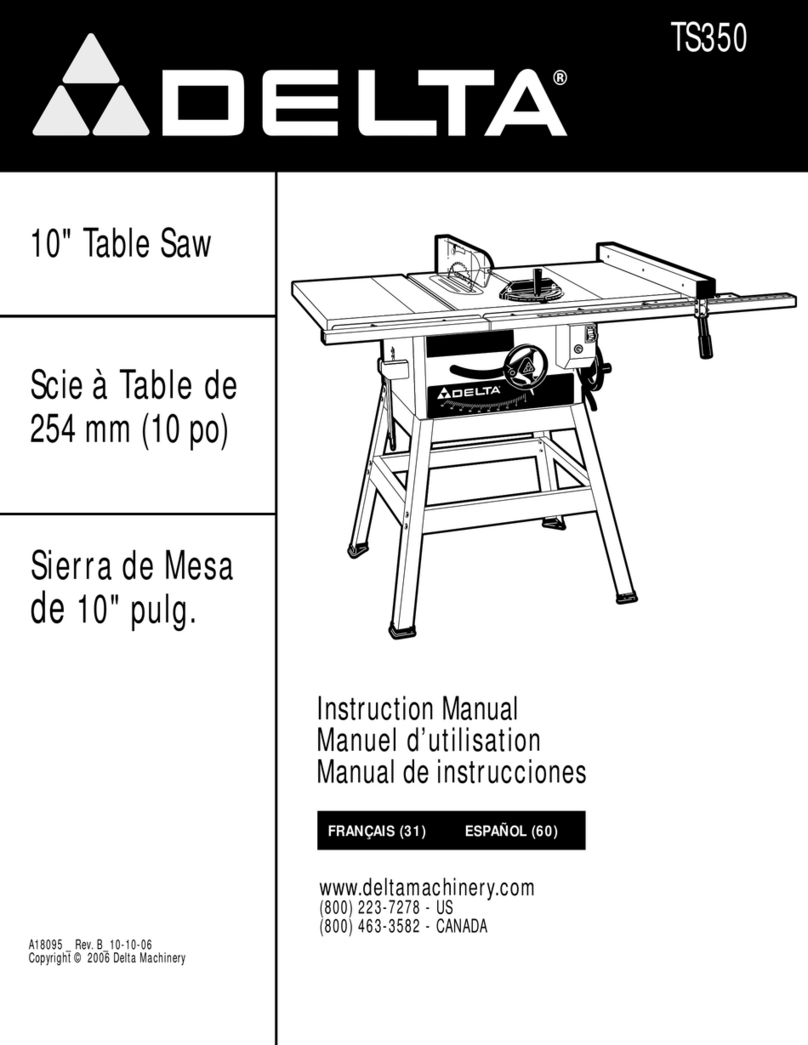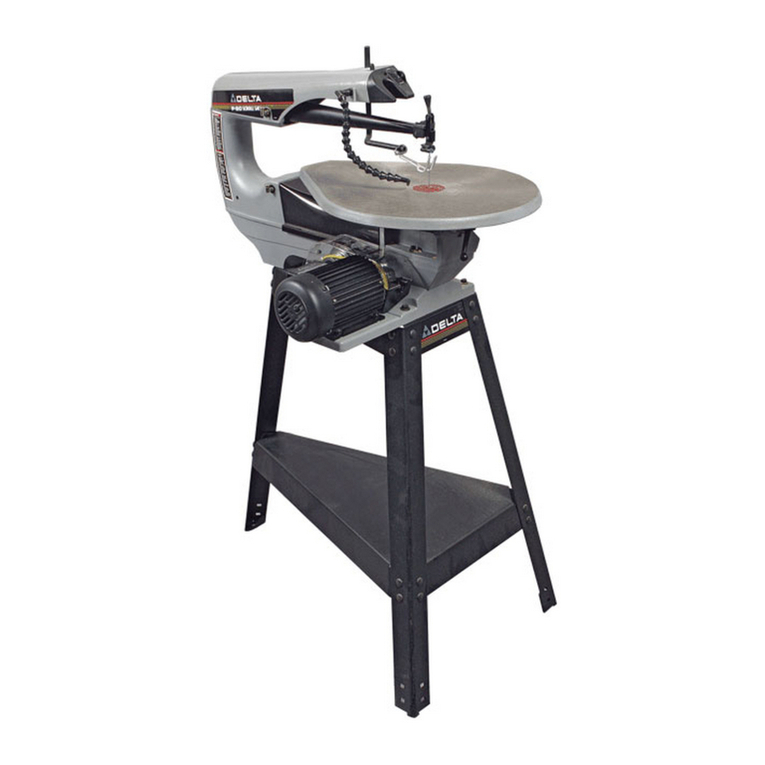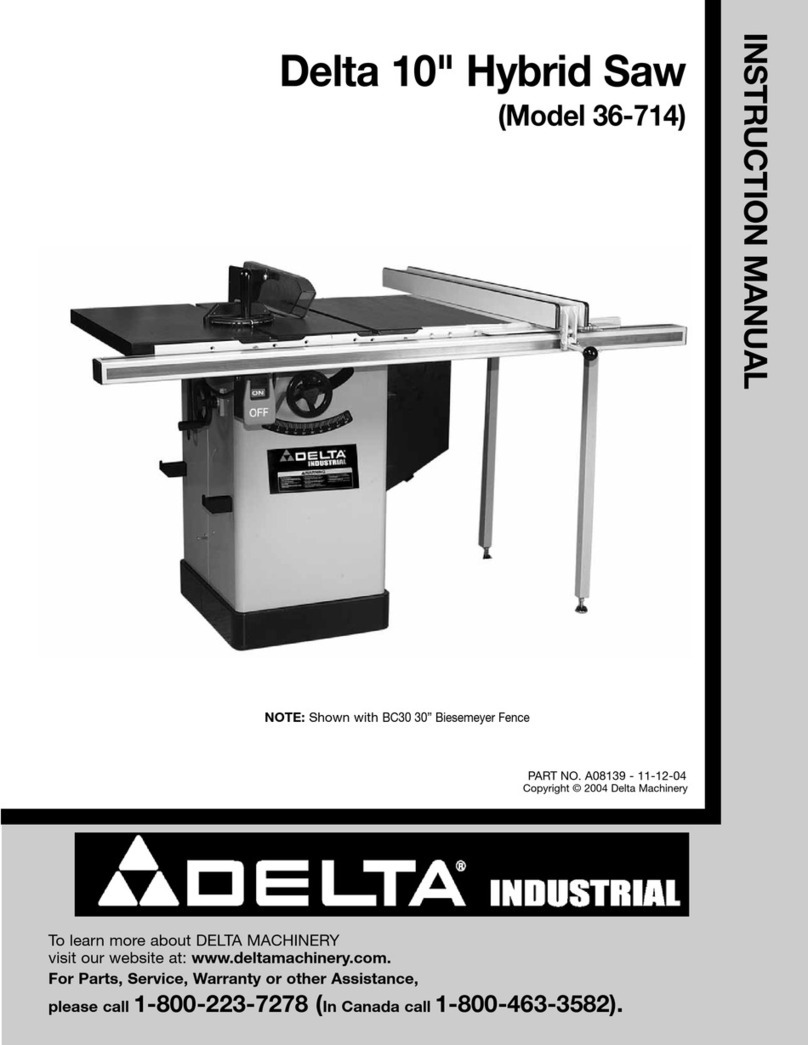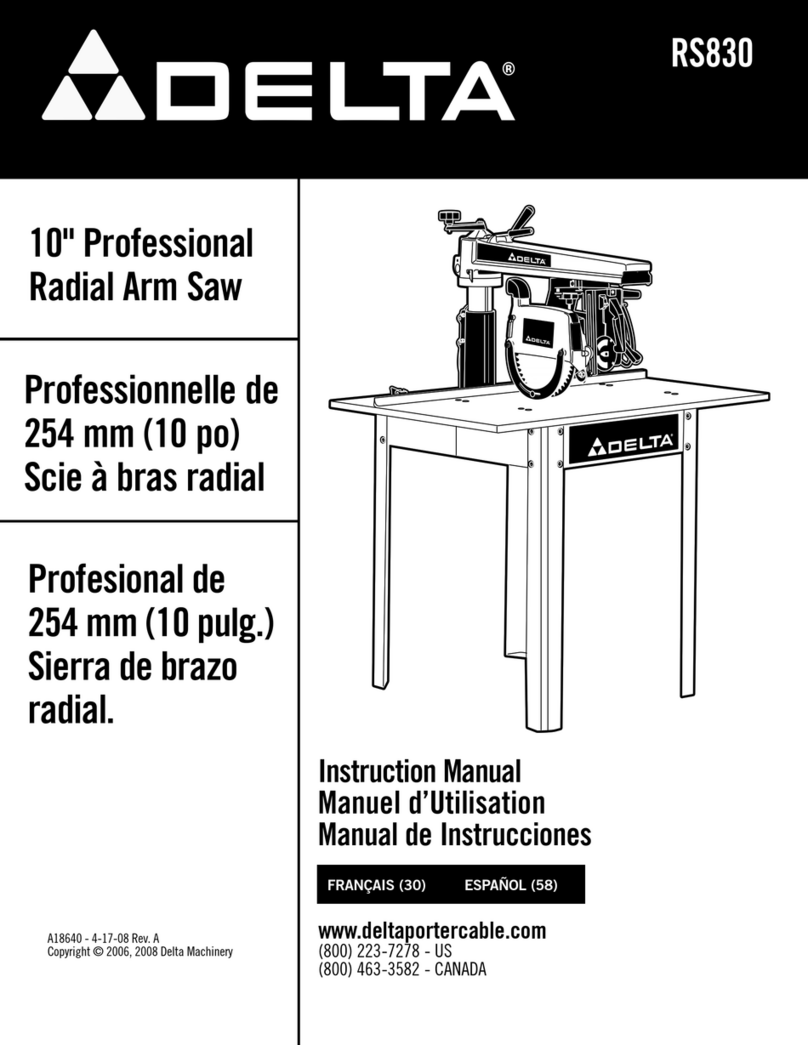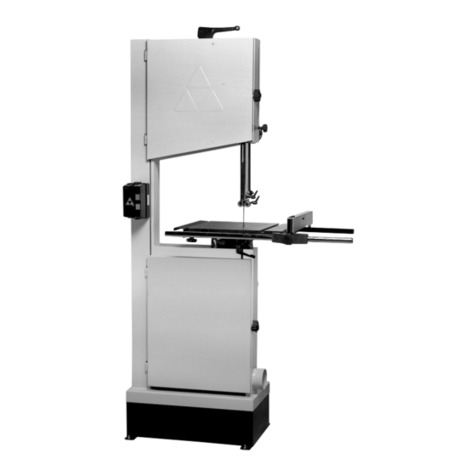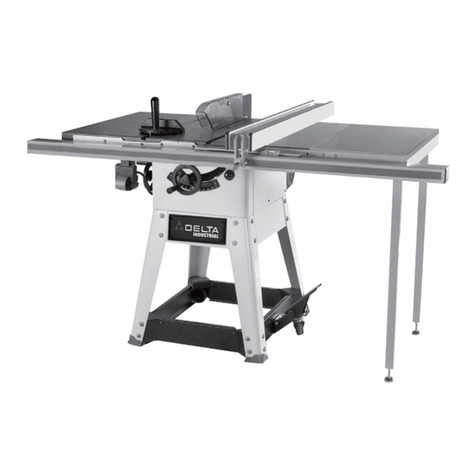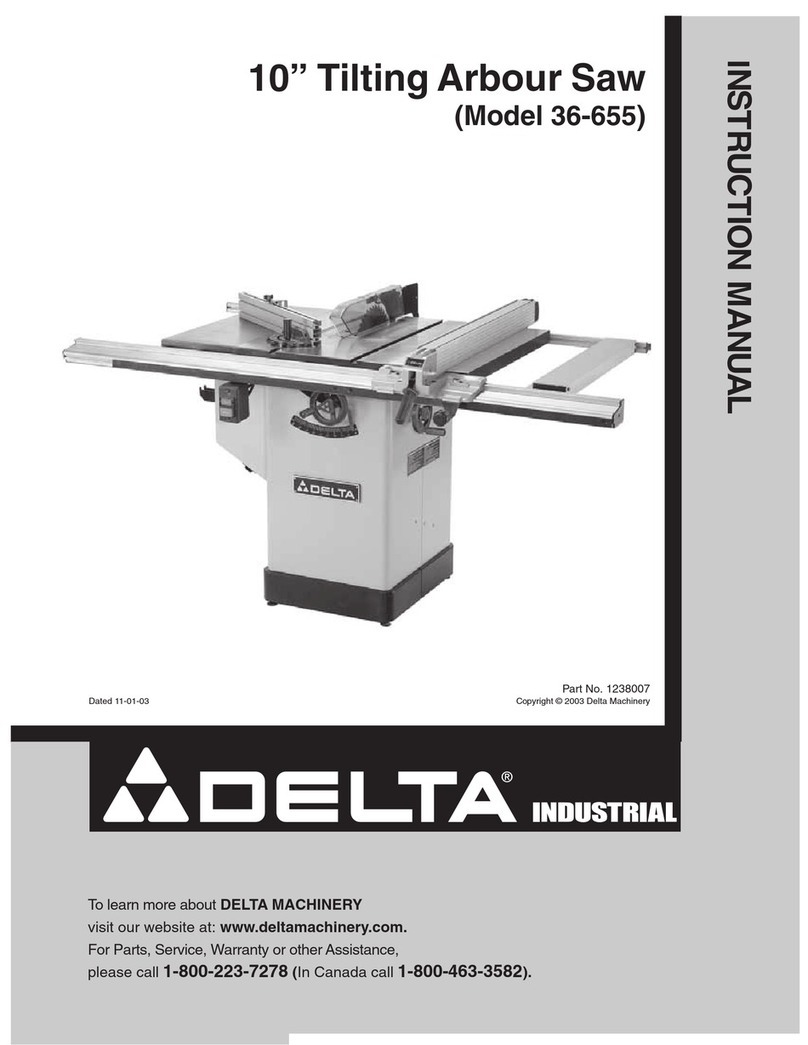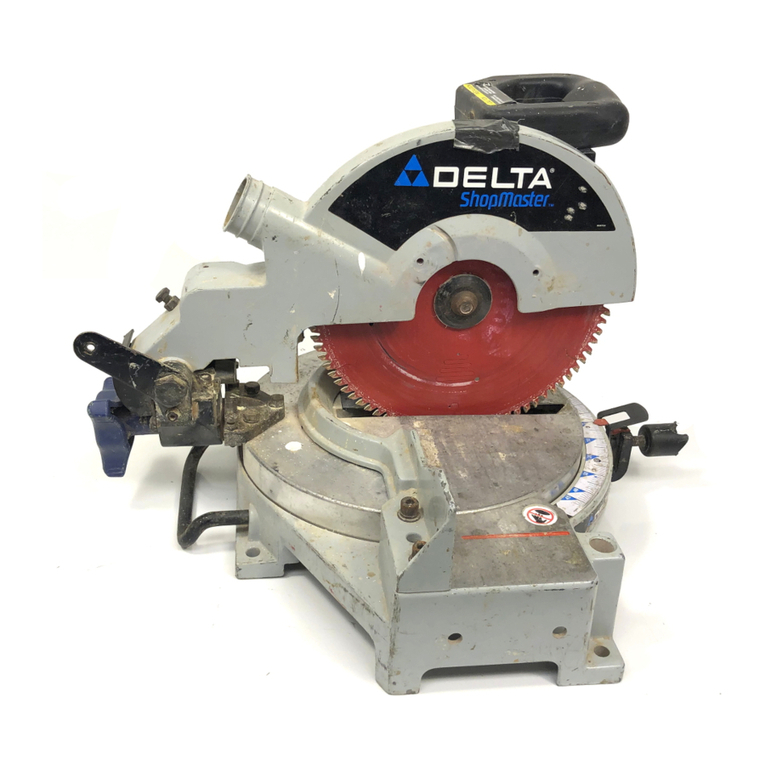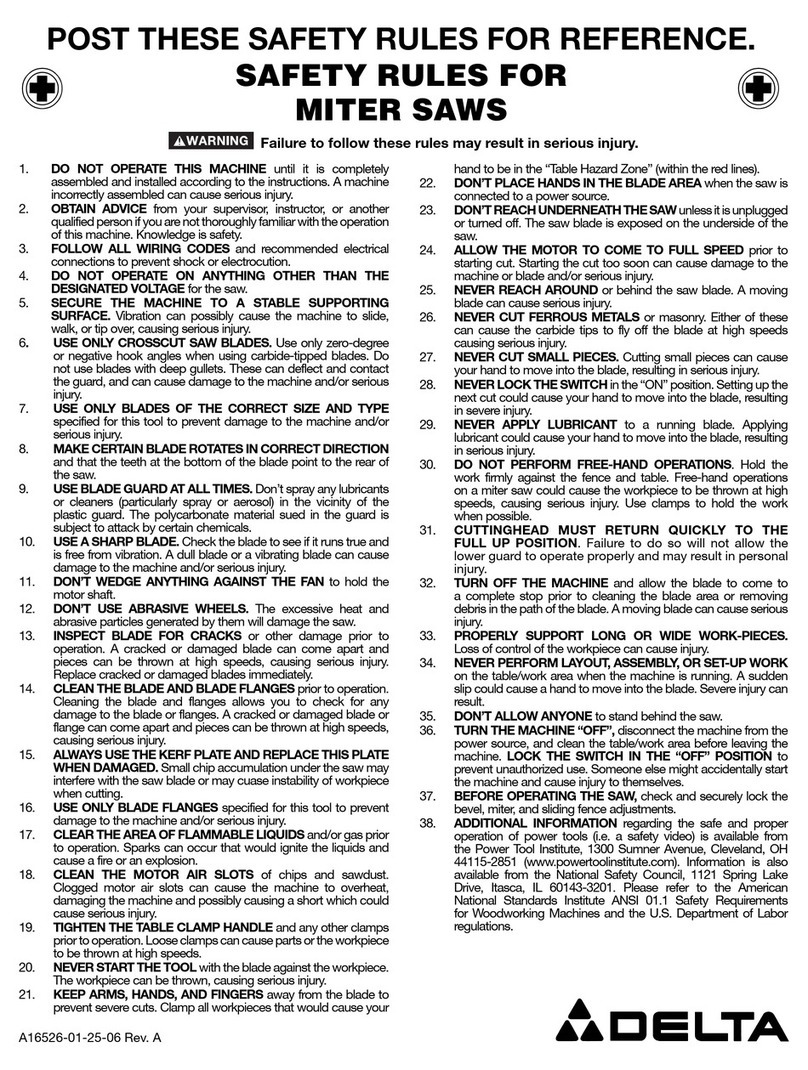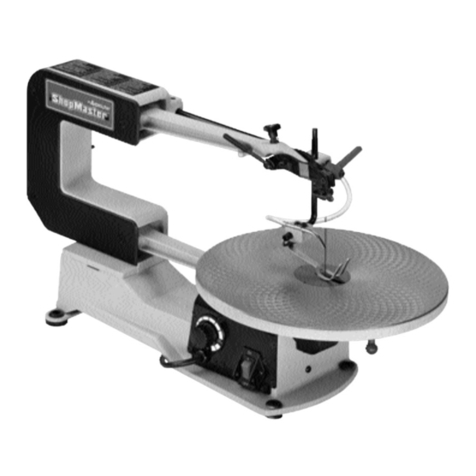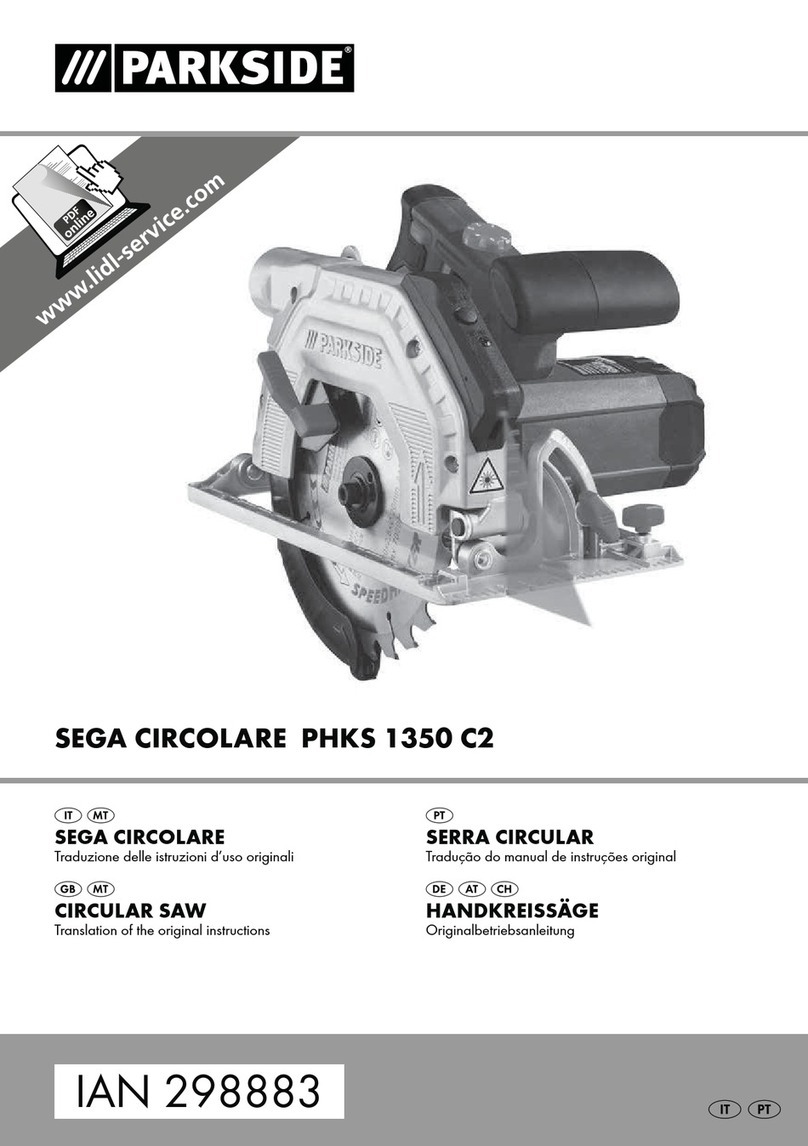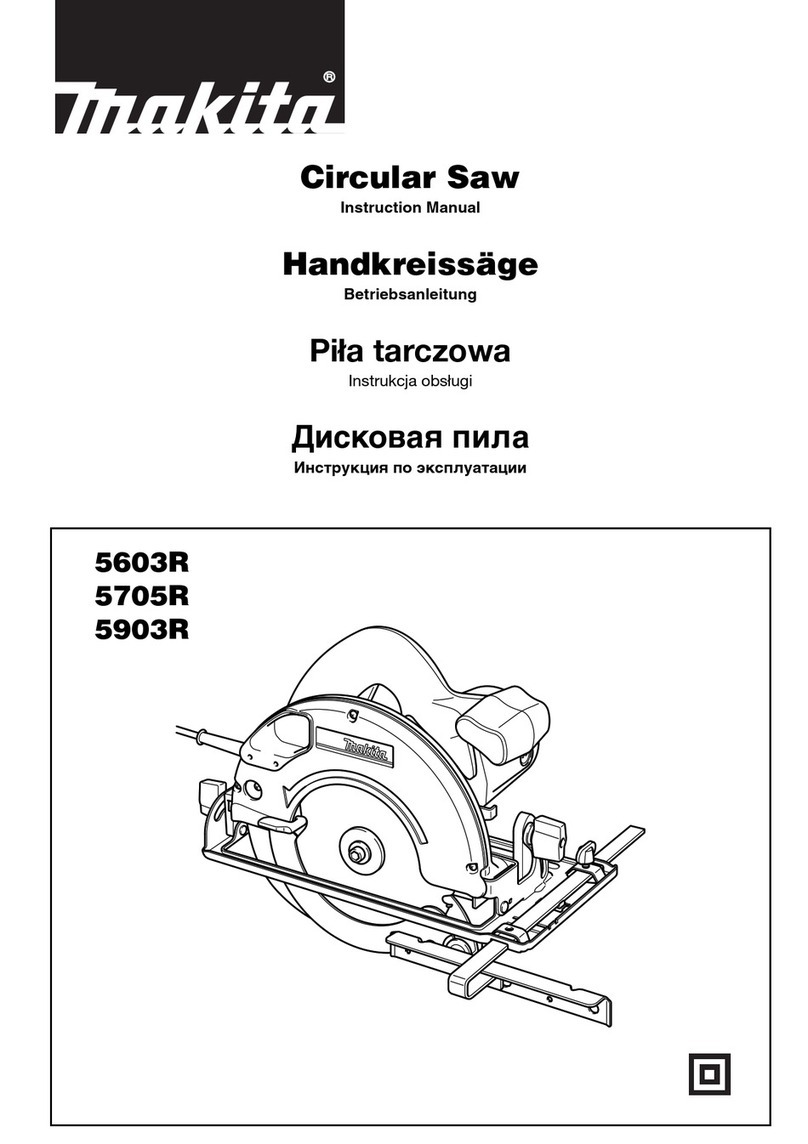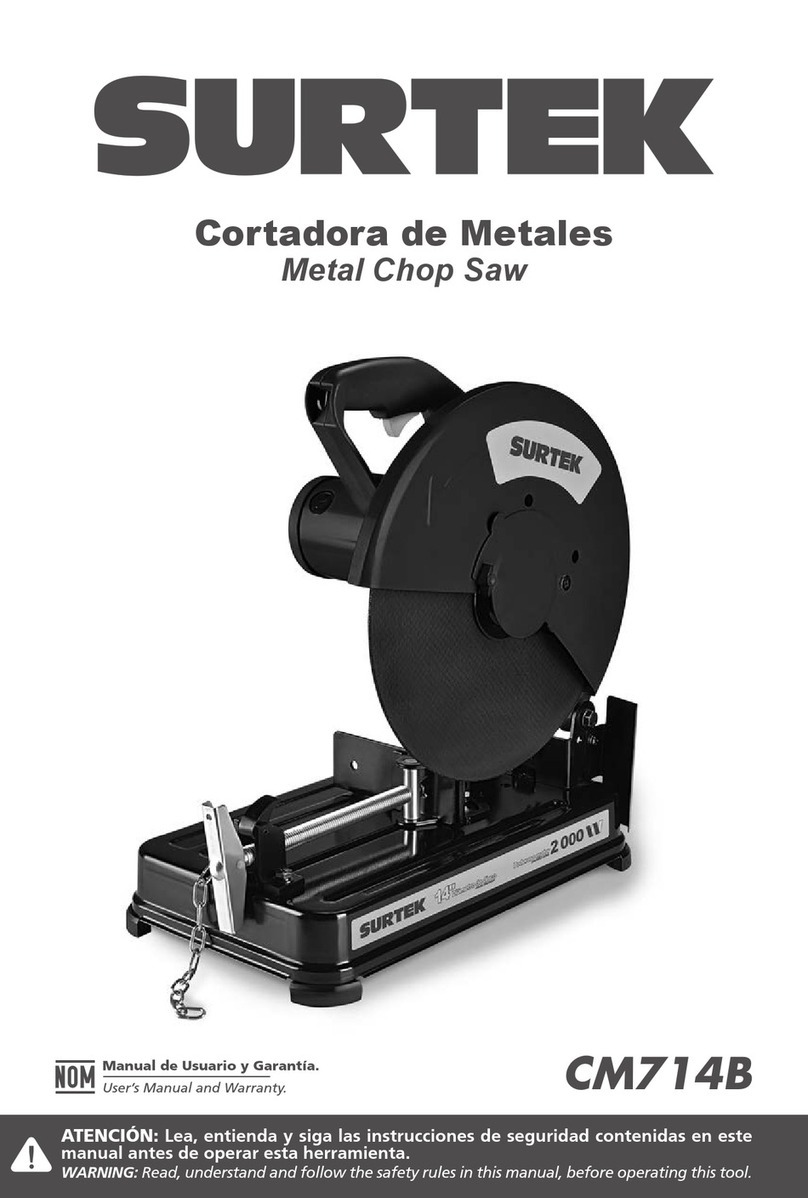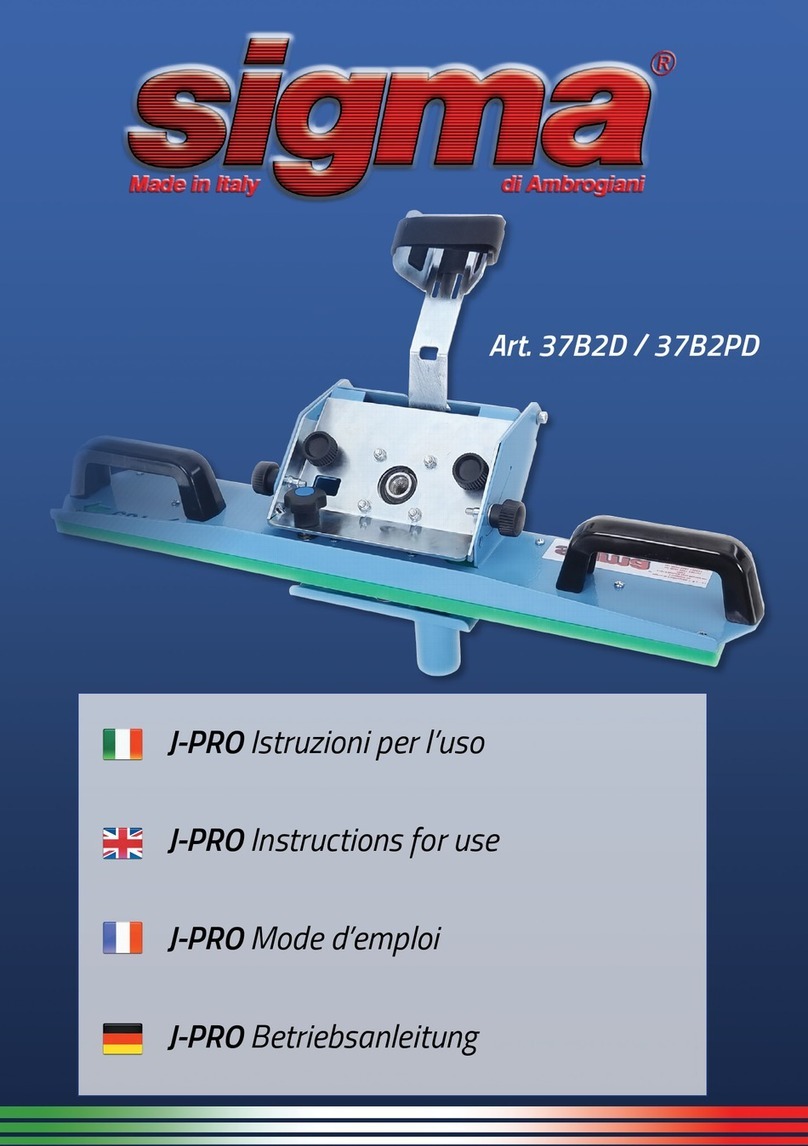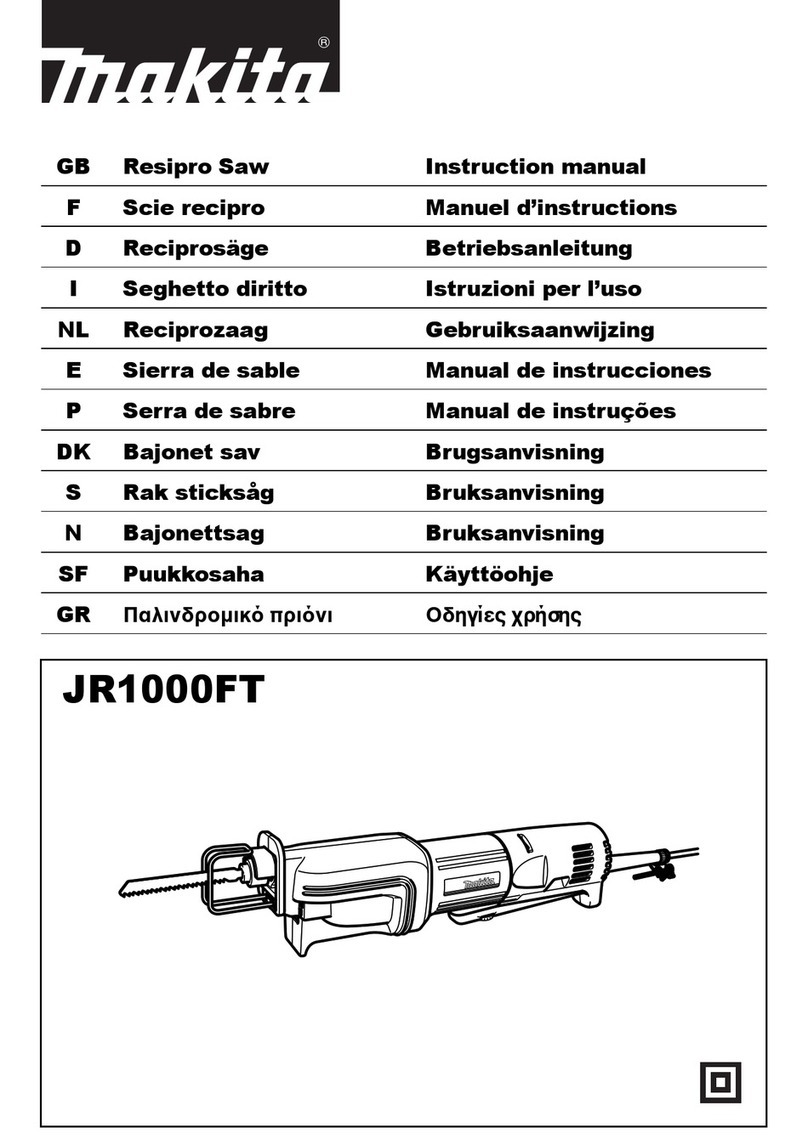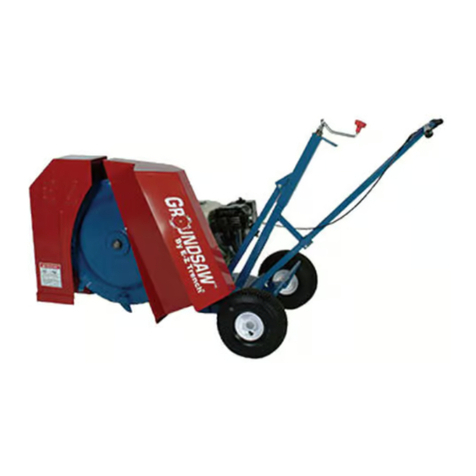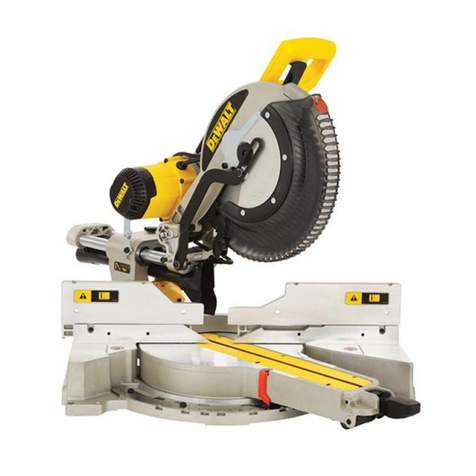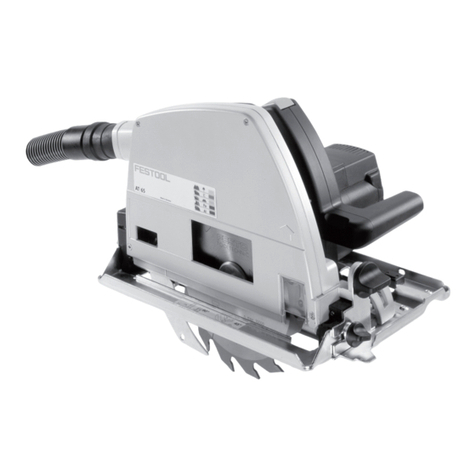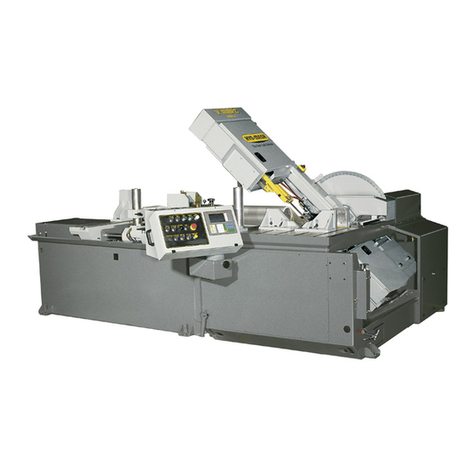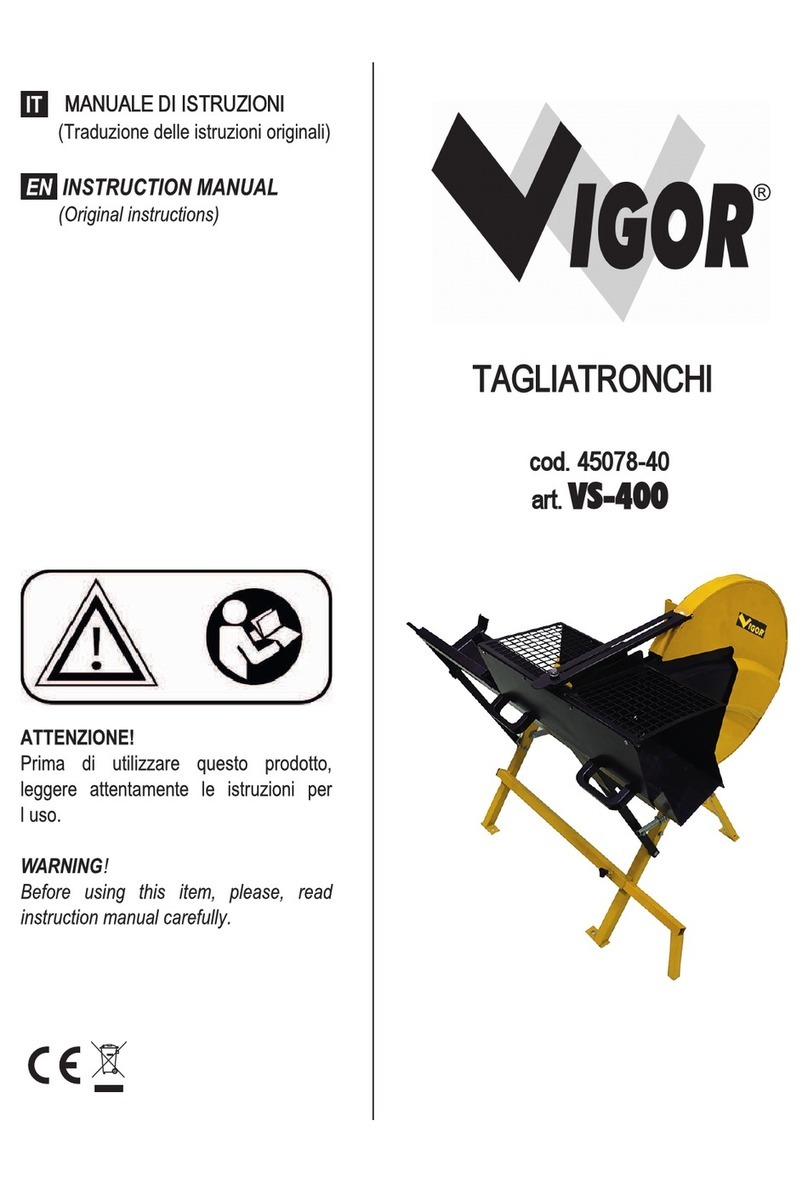Delta 36-040 User manual

INSTRUCTION MANUAL
8 1/4"
Compound Miter Saw
(Model 36-040)
PART NO. 899852 (012)
Copyright © 2001 Delta Machinery
ESPAÑOL: PÁGINA 17
To learn more about DELTA MACHINERY
visit our website at: www.deltamachinery.com.
For Parts, Service, Warranty or other Assistance,
please call 1-800-223-7278 (In Canada call 1-800-463-3582).

2
SAFETY RULES
Woodworking can be dangerous if safe and proper operating procedures are not followed. As with all machinery, there
are certain hazards involved with the operation of the product. Using the machine with respect and caution will con-
siderably lessen the possibility of personal injury. However, if normal safety precautions are overlooked or ignored, per-
sonal injury to the operator may result. Safety equipment such as guards, push sticks, hold-downs, featherboards,
goggles, dust masks and hearing protection can reduce your potential for injury. But even the best guard won’t make
up for poor judgment, carelessness or inattention. Always use common sense and exercise caution in the workshop.
If a procedure feels dangerous, don’t try it. Figure out an alternative procedure that feels safer. REMEMBER: Your
personal safety is your responsibility.
This machine was designed for certain applications only. Delta Machinery strongly recommends that this machine not
be modified and/or used for any application other than that for which it was designed. If you have any questions rela-
tive to a particular application, DO NOT use the machine until you have first contacted Delta to determine if it can or
should be performed on the product.
Technical Service Manager
Delta Machinery
4825 Highway 45 North
Jackson, TN 38305
(IN CANADA: 505 SOUTHGATE DRIVE, GUELPH, ONTARIO N1H 6M7)
WARNING: FAILURE TO FOLLOW THESE RULES MAY RESULT IN SERIOUS PERSONAL INJURY
1. FOR YOUR OWN SAFETY, READ INSTRUCTION
MANUAL BEFORE OPERATING THE TOOL. Learn the
tool’s application and limitations as well as the specific haz-
ards peculiar to it.
2. KEEP GUARDS IN PLACE and in working order.
3. ALWAYS WEAR EYE PROTECTION.
4. REMOVE ADJUSTING KEYS AND WRENCHES.
Form habit of checking to see that keys and adjusting
wrenches are removed from tool before turning it “on”.
5. KEEP WORK AREA CLEAN. Cluttered areas and
benches invite accidents.
6. DON’T USE IN DANGEROUS ENVIRONMENT. Don’t
use power tools in damp or wet locations, or expose them
to rain. Keep work area well-lighted.
7. KEEP CHILDREN AND VISITORS AWAY. All children
and visitors should be kept a safe distance from work area.
8. MAKE WORKSHOP CHILDPROOF – with padlocks,
master switches, or by removing starter keys.
9. DON’T FORCE TOOL. It will do the job better and be
safer at the rate for which it was designed.
10. USE RIGHT TOOL. Don’t force tool or attachment to
do a job for which it was not designed.
11. WEAR PROPER APPAREL. No loose clothing, gloves,
neckties, rings, bracelets, or other jewelry to get caught in
moving parts. Nonslip footwear is recommended. Wear
protective hair covering to contain long hair.
12.
ALWAYS USE SAFETY GLASSES. Wear safety glass-
es. Everyday eyeglasses only have impact resistant lens-
es; they are not safety glasses. Also use face or dust
mask if cutting operation is dusty. These safety glasses
must conform to ANSI Z87.1 requirements. Note:
Approved glasses have Z87 printed or stamped on
them.
13. SECURE WORK. Use clamps or a vise to hold work
when practical. It’s safer than using your hand and frees
both hands to operate tool.
14. DON’T OVERREACH. Keep proper footing and bal-
ance at all times.
15. MAINTAIN TOOLS IN TOP CONDITION. Keep tools
sharp and clean for best and safest performance. Follow
instructions for lubricating and changing accessories.
16. DISCONNECT TOOLS before servicing and when
changing accessories such as blades, bits, cutters, etc.
17. USE RECOMMENDED ACCESSORIES. The use of
accessories and attachments not recommended by Delta
may cause hazards or risk of injury to persons.
18. REDUCE THE RISK OF UNINTENTIONAL START-
ING. Make sure switch is in “OFF” position before plugging
in power cord.
19. NEVER STAND ON TOOL. Serious injury could occur
if the tool is tipped or if the cutting tool is accidentally con-
tacted.
20. CHECK DAMAGED PARTS. Before further use of the
tool, a guard or other part that is damaged should be care-
fully checked to ensure that it will operate properly and per-
form its intended function – check for alignment of moving
parts, binding of moving parts, breakage of parts, mount-
ing, and any other conditions that may affect its operation.
A guard or other part that is damaged should be properly
repaired or replaced.
21. DIRECTION OF FEED. Feed work into a blade or cut-
ter against the direction of rotation of the blade or cutter
only.
22. NEVER LEAVE TOOL RUNNING UNATTENDED.
TURN POWER OFF. Don’t leave tool until it comes to a
complete stop.
23. DRUGS, ALCOHOL, MEDICATION. Do not operate
tool while under the influence of drugs, alcohol or any med-
ication.
24. MAKE SURE TOOL IS DISCONNECTED FROM
POWER SUPPLY while motor is being mounted, connect-
ed or re-connected.
25. THE DUST GENERATED by certain woods and wood
products can be injurious to your health. Always operate
machinery in well ventilated areas and provide for proper
dust removal. Use wood dust collection systems whenever
possible.
26.
WARNING: SOME DUST CREATED BY
POWER SANDING, SAWING, GRINDING, DRILLING,
AND OTHER CONSTRUCTION ACTIVITIES contains
chemicals known to cause cancer, birth defects or other
reproductive harm. Some examples of these chemicals
are:
· lead from lead-based paints,
· crystalline silica from bricks and cement and other
masonry products, and
· arsenic and chromium from chemically-treated lumber.
Your risk from these exposures varies, depending on
how often you do this type of work. To reduce your
exposure to these chemicals: work in a well ventilated
area, and work with approved safety equipment, such as
those dust masks that are specially designed to filter out
microscopic particles.
SAVE THESE INSTRUCTIONS

33
ADDITIONAL SAFETY RULES FOR
MITER SAWS
1. USE ONLY CROSS-CUTTING SAW BLADES.
WHEN USING CARBIDE TIPPED BLADES, DO NOT
USE BLADES WITH DEEP GULLETS AS THEY CAN
DEFLECT AND CONTACT GUARD.
2. DO NOT OPERATE the miter saw until it is com-
pletely assembled and installed according to the instruc-
tions.
3. IF YOU ARE NOT thoroughly familiar with the oper-
ation of compound miter saws, obtain advice from your
supervisor, instructor or other qualified person.
4. DO NOT perform any operation freehand. Secure or
clamp workpiece firmly against fence.
5. KEEP HANDS OUT OF PATH of saw blade. If the
workpiece you are cutting would cause your hand to be
within hazard zone of the saw blade, the workpiece
should be clamped in place before making cut.
6. BE SURE blade is sharp, runs freely and is free of
vibration.
7. ALLOW the motor to come up to full speed before
starting cut.
8. KEEP motor air slots clean and free of chips.
9. ALWAYS MAKE SURE all clamp handles are tight
before cutting, even if the table is positioned in one of
the positive stops.
10. BE SURE blade and flanges are clean and that
arbor screw is tightened securely.
11. USE only blade flanges supplied for your saw.
12. NEVER use blades larger or smaller in diameter than
8-1/4" inches.
13. NEVER apply lubricants to the blade when it is
running.
14. ALWAYS check the blade for cracks or damage
before operation. Replace cracked or damaged blade
immediately.
15. NEVER use blades recommended for operation at
less than 6000 RPM.
16. DO NOT operate the saw without guards in place.
17. ALWAYS keep the lower blade guard in place and
operating properly.
18. NEVER reach around or behind saw blade.
19. MAKE SURE blade is not contacting workpiece
before switch is turned on.
20. NEVER lock the switch in the “ON” position.
21. AFTER COMPLETING CUT, release power switch
and wait for coasting blade to stop before returning saw
to raised position.
22. TURN OFF tool and wait for saw blade to stop
before moving workpiece or changing settings.
23. DO NOT remove jammed or cut-off pieces until blade
has stopped.
24. NEVER cut ferrous metals or masonry.
25. NEVER recut small pieces.
26. PROVIDE adequate support to the sides of the saw
table for long workpieces.
27. NEVER use the miter saw in an area with flammable
liquids or gases.
28. NEVER use solvents to clean plastic parts. Solvents
could possibly dissolve or otherwise damage the materi-
al. Only a soft damp cloth should be used to clean plas-
tic parts.
29. DISCONNECT power before changing blades or
servicing.
30. DISCONNECT saw from power source and clean
the machine before leaving it.
31. MAKE SURE the work area is cleaned before leav-
ing the machine.
32. THE USE of attachments and accessories not rec-
ommended by Delta may result in the risk of injuries.
33. SHOULD any part of your miter saw be missing,
damaged or fail in any way, or any electrical component
fail to perform properly, shut off switch and remove plug
from power supply outlet. Replace missing, damaged or
failed parts before resuming operation.
34. ADDITIONAL INFORMATION regarding the safe
and proper operation of this product is available from
the National Safety Council, 1121 Spring Lake Drive,
Itasca, IL 60143-3201, in the Accident Prevention
Manual for Industrial Operation and also in the Safety
Data Sheets provided by the NSC. Please also refer to
the American National Standard Institute ANSI 01.1
Safety Requirements for Woodworking Machinery and
the U.S. Department of Labor OSHA 1910.213
Regulations.
35. SAVE THESE INSTRUCTIONS. Refer to them often
and use them to instruct others.

4
UNPACKING
Your new Miter Saw is shipped complete in one con-
tainer. Carefully unpack the saw and all loose items
from the shipping container. Fig. 2, illustrates the con-
tents of the container:
A - Miter Saw
B - Lower Guard Assembly
C - Dust Bag
* - Extra Switch Lock Key
(Not Shown)
Fig. 2
ASSEMBLY INSTRUCTIONS
WARNING: FOR YOUR OWN SAFETY, DO NOT CONNECT THE MITER SAW TO THE POWER SOURCE
UNTIL THE MACHINE IS COMPLETELY ASSEMBLED AND YOU HAVE READ AND UNDERSTOOD THE
ENTIRE OWNER’S MANUAL.
MOVING CUTTING ARM TO THE UP POSITION
1. Pull pin (A) Fig. 3, to the out position releasing the cutting arm (B) and allow cutting arm (B) to move to the up posi-
tion, as shown in Fig. 4.
Fig. 3 Fig. 4
ASSEMBLING LOWER BLADE GUARD
1. Hook one end of guard lifting lever (A) Fig. 5, on stud (B), as shown.
2. Loosen screw (D) Fig. 6, and remove screw (C)
Fig. 5 Fig. 6
A
C
B
A
B
A
B
D
C
B

5
3. Slide slotted end (E) Fig. 7, of lower guard mounting
bracket under screw head (D). Make sure screw and
spacer (K) is engaged with slot (L) in guard lifting lever
and rotate lower guard mounting bracket (F) until hole (G)
in bracket lines up with threaded hole (H) in upper guard.
4. Replace screw (C) Fig. 8, that was removed in
STEP 2. Tighten screw (D) and screw (C).
ASSEMBLING DUST BAG
Assemble dust bag assembly (A) Fig. 9, to dust spout (B)
on rear of upper guard assembly, as shown.
FASTENING COMPOUND MITER
SAW TO SUPPORTING SURFACE
CAUTION: Before operating your compound miter saw,
make sure it is firmly mounted to a sturdy work bench or
other supporting surface. Four holes are provided, two
of which are shown at (A) Fig. 10, for fastening the saw
to a supporting surface.
When frequently moving the saw from place to place,
we suggest that the saw be mounted to a 1/2" or 3/4"
piece of plywood. The saw can then be easily moved
and the plywood clamped to the supporting surface
using “C” clamps. Fig. 10
Fig. 9
Fig. 8
Fig. 7
LHF
G
K
D
E
C
D
B
A
A

6
CONNECTING SAW TO POWER SOURCE
POWER CONNECTIONS
A separate electrical circuit should be used for your tools. This circuit should not be less than #12 wire and should be
protected with a 20 Amp time lag fuse. Before connecting the motor to the power line, make sure the switch is in the
“OFF” position and be sure that the electric current is of the same characteristics as indicated on the tool. All line con-
nections should make good contact. Running on low voltage will damage the motor.
MOTOR SPECIFICATIONS
Your miter saw is wired for 110-120 volt, 60 HZ alternating current. Before connecting the miter saw to the power
source, make sure the switch is in the “OFF” position. The motor provides a no-load speed of 5200 RPM.
DOUBLE-INSULATED TOOLS
REPLACEMENT PARTS
When servicing, use only identical replacement parts.
POLARIZED PLUGS
To reduce the risk of electric shock, this equipment has a polarized plug one blade is wider than the other). This plug
will fit in a polarized outlet only one way. If the plug does not fit fully in the outlet, reverse the plug. If it still does not fit,
contact a qualified electrician to install the proper outlet. Do not change the plug in any way.

7
Use proper extension cords. Make sure your extension
cord is in good condition. When using an extension
cord, be sure to use one heavy enough to carry the cur-
rent of the saw. An undersized cord will cause a drop in
line voltage, resulting in loss of power and overheating.
Fig. 11B, shows the correct gauge to use depending on
the cord length. If in doubt, use the next heavier gauge.
The smaller the gauge number, the heavier the cord.
Fig. 11B
EXTENSION CORDS
OPERATING INSTRUCTIONS
FOREWORD
Delta Model 36-040 is a 81¼4" compound miter saw designed to cut wood. Compound angle and bevel cutting is easy
and accurate. It can crosscut up to 21¼8" x 51¼8", miter at 45°both left and right 21¼8" x 31¼2", bevel at 45°left 11¼2" x
51¼8", and compound 45°x 45°, 11¼2" x 31¼2". It has positive miter ball detent stops at 0, 15, 22.5, 30, and 45 degrees
both left and right, and bevel stops at 0 and 45 degrees left.
UNPACKING AND CLEANING
Carefully unpack the tool and all loose items from the shipping container(s). Remove the protective coating from all
unpainted surfaces. This coating may be removed with a soft cloth moistened with kerosene (do not use acetone, gaso-
line or lacquer thinner for this purpose). After cleaning, cover the unpainted sufaces with a good quality paste wax.
MINIMUM GAUGE EXTENSION CORD
RECOMMENDED SIZES FOR USE WITH STATIONARY ELECTRIC TOOLS
Ampere Volts Total Length of Gauge of
Rating Cord in Feet Extension Cord
0-6 120 up to 25 18 AWG
0-6 120 25-50 16 AWG
0-6 120 50-100 16 AWG
0-6 120 100-150 14 AWG
6-10 120 up to 25 18 AWG
6-10 120 25-50 16 AWG
6-10 120 50-100 14 AWG
6-10 120 100-150 12 AWG
10-12 120 up to 25 16 AWG
10-12 120 25-50 16 AWG
10-12 120 50-100 14 AWG
10-12 120 100-150 12 AWG
12-16 120 up to 25 14 AWG
12-16 120 25-50 12 AWG
12-16 120 GREATER THAN 50 FEET NOT RECOMMENDED

8
OPERATING CONTROLS
LOCKING SWITCH IN THE “OFF” POSITION
IMPORTANT: When the saw is not in use, the switch
must be locked in the “OFF” position.
WARNING: MAKE CERTAIN THE MACHINE IS
DISCONNECTED FROM THE POWER SOURCE
BEFORE REMOVING AND REASSEMBLING SWITCH
LOCK KEY.
To lock the switch (B) Fig. 12, in the “OFF” position, pull
or gently pry out and remove switch lock key (A) from
saw handle.
To activate the switch (B) Fig. 12, insert switch lock key
(A) firmly back into handle.
ROTATING TABLE FOR MITER CUTTING
Your compound miter saw will cut any miter angle from
a straight 90 degree cut-off to 45 degrees right and left.
Simply loosen table lock knob (A) Fig. 13, and using the
switch handle as a grip, rotate the cutting arm until the
pointer (B) aligns with the desired setting on the miter
scale (C). Then tighten table lock knob (A).
WARNING: LOCK KNOB (A) MUST BE TIGHT-
ENED FOR ALL CUTTING OPERATIONS.
Your compound miter saw contains positive stops for
the table at the 0, 22-1/2, 30 and 45 degree right and left
positions. Two triangle indicators (D) Fig. 14, are also
provided to rapidly set the table at the 31-5/8 degree
right and left miter angle for cutting crown moulding, as
explained later in this manual.
TILTING CUTTING ARM
FOR BEVEL CUTTING
Loosen bevel cutting lock handle (A) Fig. 15, tilt cutting
arm to the desired bevel angle and tighten lock handle
(A). NOTE: Lock handle (A) is spring-loaded and can be
re-positioned by pulling out on the handle and reposi-
tioning it on the serrated stud located underneath the
handle.
WARNING: LOCK HANDLE (A) MUST BE TIGHT-
ENED DURING ALL CUTTING OPERATIONS.
The bevel angle of the cutting arm is determined by the
position of the pointer (B) Fig. 15, on the large scale (C).
A triangle indicator (D) is provided to rapidly position the
cutting arm at the 33-7/8 degree left bevel angle which
is used for cutting crown moulding, as explained later in
this manual.
Fig. 12
STARTING AND STOPPING SAW
IMPORTANT: Before starting the saw, lower the cutting arm and make certain the saw blade does not come in contact
with the front edge or rear edge of the table insert on its full downward travel. The downward travel of the cutting arm
has been set at the factory; however, sometimes due to rough handling during shipment or extended use, a minor
adjustment to the setting may become necessary. If the saw blade contacts the table insert, refer to section “ADJUST-
ING DOWNWARD TRAVEL OF SAW BLADE.”
To turn the saw “ON” push in on switch lock key (A) Fig. 12, and depress switch trigger (B). To turn the saw “OFF”
release switch trigger (B).
Fig. 13
Fig. 14
Fig. 15
D
D
A
D
B
C
B
A
C
A
B

9
LOCKING CUTTING ARM
IN THE DOWN POSITION
When transporting the miter saw, the cutting arm should
always be locked in the down position. This can be
accomplished by lowering the cutting arm and pushing
in on arm locking pin (A) Fig. 16.
ADJUSTMENTS
ADJUSTING DOWNWARD TRAVEL
OF SAW BLADE ARM
Lower the saw blade arm as far as it will go and check
to see if the saw blade comes in contact with the table
insert. If the saw blade (A) Fig. 17, contacts the front
edge or the rear edge of table insert (B) on its downward
travel, proceed with the following adjustment.
1. MAKE CERTAIN THE MACHINE IS DISCONNECT-
ED FROM THE POWER SOURCE.
2. Loosen lock nut (C) Fig. 18, and turn adjustment knob
(D) right or left.
3. Lower the saw blade arm and check the adjustment.
NOTE: There should be a slight clearance between the
saw blade (A) Fig. 17, and table insert (B) as shown.
Repeat STEP 2, if necessary.
4. Tighten lock nut (C) Fig 18, after adjustment is made.
ADJUSTING FENCE 90 DEGREES
TO BLADE
1. DISCONNECT THE MACHINE FROM THE POWER
SOURCE.
2. Place the cutting arm in the 90 degree straight cut-off
position, as shown in Fig. 19, and tighten the table lock
knob (A).
3. Lower the saw blade, as shown in Fig. 19.
4. Using a square (B) Fig. 19, place one end of the
square against the fence and the other end against the
blade, as shown.
5. Check to see if the blade is at 90 degrees to the fence.
6. If an adjustment is necessary, loosen the two screws
(C) Fig. 20, and adjust the fence until it is 90 degrees to
the blade. Then tighten two screws (C).
Fig. 16
Fig. 17
Fig. 18
Fig. 19 Fig. 20
A
B
A
DC
A
B
C
C

10
ADJUSTING 90 AND 45 DEGREE
BEVEL STOPS
1. DISCONNECT THE MACHINE FROM THE POWER
SOURCE.
2. Move the cutting arm to the 90 degree bevel stop
position, as shown in Fig. 21, and tighten the bevel lock
handle.
3. Using a square (A) Fig. 21, place one end of the
square on the table and the other end against the blade.
Check to see if the blade is at 90 degrees to the table,
as shown.
4. If an adjustment is necessary, loosen bevel lock han-
dle (B) Fig. 22, and tilt cutting arm until the blade is at 90
degrees to the table. NOTE: It may be necessary to
loosen locknut (C) and set screw (D) to accomplish this.
Then tighten bevel lock handle (B).
5. Loosen nut (C) Fig. 22, and tighten set screw (D) until
it bottoms. Then tighten locknut (C).
6. Tilt the cutting arm all the way to the left miter posi-
tion and tighten the bevel lock handle.
7. Using a combination square (A) Fig. 23, check to see
if the blade is at 45 degrees to the table, as shown.
8. If an adjustment is necessary, loosen bevel lock han-
dle (B) Fig. 24, and tilt the cutting arm until the blade is
at 45 degrees to the table. NOTE: It may be necessary
to loosen locknut (E) and set screw (F) to accomplish
this. Then tighten bevel lock handle (B).
9. Loosen locknut (E) Fig. 24, and tighten set screw (F)
until it bottoms. Then tighten locknut (E).
10. These positive stops enable you to rapidly position
the blade at the 90 and 45 degree bevel positions.
Fig. 21
Fig. 22
A
B
C
Fig. 23
A
Fig. 24
B
EF
D

11
ADJUSTING SPRING PRESSURE OF
TABLE POSITIVE STOP
The rotating table has positive stops at the 90 degree
straight cut-off position and 22-1/2, 30 and 45 degree
right and left miter positions. To adjust the spring pres-
sure of the positive stops, tighten or loosen screw (A) Fig.
25. NOTE: Do not tighten screw (A) to the point where it
becomes difficult to rotate the table.
Fig. 25
OPERATING HINTS
1. Before cutting, make certain the miter and bevel angles are set and firmly locked in place.
2. Before cutting, determine that the workpiece is the right size for the saw.
3. Place the workpiece on the table and hold it firmly against the fence.
4. For best results, cut at a slow, even cutting rate.
5. WARNING: Keep hands out of path of saw blade. If the workpiece you are cutting would cause your
hand to be within hazard zone of the saw blade, the workpiece should be clamped in place before
making cut.
6. Never attempt any freehand cutting (wood that is not held firmly against the fence and table).
A

12
MAINTENANCE
CHANGING THE BLADE
WARNING: USE ONLY CROSS-CUTTING SAW
BLADES. WHEN USING CARBIDE TIPPED BLADES,
DO NOT USE BLADES WITH DEEP GULLETS AS THEY
CAN DEFLECT AND CONTACT GUARD. USE ONLY
8-1/4" DIAMETER SAW BLADES RATED FOR 6000
RPM OR HIGHER WITH 5/8" ARBOR HOLES.
1. DISCONNECT THE MACHINE FROM THE POWER
SOURCE.
2. Loosen screws (B) and (C) Fig. 28, and rotate lower
blade guard assembly to the up position.
3. Press in on arbor lock (D) Fig. 29, to keep the arbor
from turning, and unscrew and remove arbor screw (E).
NOTE: Turn arbor screw (E) clockwise to remove.
4. Remove outside blade flange (F) Fig. 30, and saw
blade (G).
5. To install new blade make sure inside blade flange (H)
Fig. 31, is completely on arbor with the flats in the flange
engaged with the flats on the arbor.
6. Install new blade (J) Fig. 32, outside blade flange (F)
and arbor screw (E). Turn arbor screw counterclockwise
to tighten while pressing in on arbor lock to keep the
arbor from turning. IMPORTANT: Make sure flats in out-
side blade flange are engaged with flats on arbor shaft
and that teeth of saw blade are pointing down at the
front, as shown in Fig. 30.
Fig. 30
Fig. 29
Fig. 28
Fig. 32
B
C
D
E
G
F
J
F
E
Fig. 31
H

13
Fig.33
Fig. 34
CUTTING ALUMINUM
Aluminum extrusions such as used for making aluminum
screens and storm windows can easily be cut with your
compound miter saw. When cutting aluminum extrusions,
or other sections that can be cut with a saw blade and are
within the capacity of the machine, position the material
so the blade is cutting through the smallest cross-
section, as shown in Fig. 33. The wrong way to cut
aluminum angles is illustrated in Fig. 34. Be sure to apply
a stick wax (similar to Johnson’s stick wax #140) to the
blade before cutting any aluminum stock. This stick wax
is available at most industrial mill supply houses. The
stick wax provides proper lubrication and keeps chips
from adhering to the blade.
WARNING: NEVER APPLY LUBRICANT TO THE
BLADE WHILE THE MACHINE IS RUNNING.
FENCE BLADE
WRONG
FENCE
BLADE
RIGHT
CUTTING BOWED MATERIAL
When cutting flat pieces, first check to see if the material is bowed. If it is, make sure the material
is positioned on the table as shown in Fig. 35.
If the material is positioned the wrong way, as shown in Fig. 36, the workpiece will pinch the blade
near the completion of the cut.
Fig. 35
Fig. 36
RIGHT
WRONG

14
Fig. 37
Fig. 38
Fig. 39
Fig. 40
C
D
CA
D
B
CUTTING
CROWN MOULDING
One of the many features of your saw is the ease of cut-
ting crown moulding. The following is an example of cut-
ting both inside and outside corners on 52/38 degree
wall angle crown moulding. NOTE: When cutting 45
degree wall angle crown moulding the following proce-
dure for inside and outside corners is the same with the
exception that the bevel position will always be at 30
degrees and the miter position will be 35-1/4 degrees to
the right or left.
1. Move the table to the 31-5/8 degree right miter posi-
tion and lock the table in position. NOTE: A triangle indi-
cator is provided on the miter scale to find this angle
quickly.
2. Tilt the saw blade to the 33-7/8 degree left bevel posi-
tion and tighten bevel lock handle. NOTE: A triangle
indicator is provided on the bevel scale to find this angle
quickly.
3. Place the crown moulding on the table with the
CEILING EDGE of the moulding against the fence, and
make the cut, as shown in Fig. 37. NOTE: The piece of
crown moulding used for the outside corner will always
be on the right hand side of the blade, as shown at (A)
Fig. 37. The piece of crown moulding used for the inside
corner will always be on the left hand side of the blade,
as shown at (B) Fig. 37.
4. To make the matching halves of the inside and outside
corners simply rotate the table to the 31-5/8 degree left
miter position and tighten table lock handle. NOTE: A tri-
angle indicator is provided on the miter scale to find this
angle quickly.
5. Place the crown moulding on the table with the WALL
EDGE of the crown moulding against the fence as
shown in Fig. 38, then make the cut. Again, the piece of
crown moulding used for the outside corner will always
be on the right side of the blade, as shown at (C) Fig. 38.
The piece of crown moulding used for the inside corner
will always be on the left side of the blade, as shown at
(D) Fig. 38.
6. Fig. 39, illustrates the two outside corner pieces;
(A) being the piece cut at (A) Fig. 37, and (C) being the
piece cut at (C) Fig. 38.
7. Fig. 40, illustrates the two inside corner pieces;
(B) being the piece cut at (B) Fig. 37, and (D) being the
piece cut at (D) Fig. 38.
BA

15
BRUSH INSPECTION
AND REPLACEMENT
CAUTION: BEFORE INSPECTING THE BRUSHES,
DISCONNECT THE MACHINE FROM THE POWER
SOURCE.
Brush life varies. It depends on the load on the motor.
Check the brushes after the first 50 hours of use for a
new machine or after a new set of brushes has been
installed.
After the first check, examine them after about 10 hours
of use until such time that replacement is necessary.
The brush holders (A) Fig. 41, are located on the motor
housing opposite each other. Fig. 42, illustrates one of
the brushes removed for inspection. When the carbon on
either brush is worn to 3/16" in length or if either spring
or shunt wire is burned or damaged in any way, replace
both brushes. If the brushes are found serviceable after
removing, reinstall them in the same position as
removed.
Fig. 41
Fig. 42
TABLE HAZARD AREA
WARNING: THE AREA INSIDE THE TWO RED LINES (A) FIG. 43, ON THE TABLE IS DESIGNATED AS A
HAZARD ZONE. NEVER PLACE YOUR HANDS INSIDE THIS AREA WHILE THE TOOL IS BEING
OPERATED.
Fig. 43
A
A

161616
PARTS, SERVICE OR WARRANTY ASSISTANCE
All Delta Machines and accessories are manufactured to high quality standards and are serviced by
a network of
Porter-Cable
Delta
Factory Service Centers and Delta Authorized Service Stations. To
obtain additional information regarding your Delta quality product or to obtain parts, service, warranty
assistance, or the location of the nearest service outlet, please call 1-800-223-7278
( in Canada call 1-800-463-3582).
Delta Building Trades and Home Shop Machinery
Two Year Limited Warranty
Delta will repair or replace, at its expense and at its option, any Delta machine, machine part, or machine accessory which
in normal use has proven to be defective in workmanship or material, provided that the customer returns the product pre-
paid to a Delta factory service center or authorized service station with proof of purchase of the product within two years
and provides Delta with reasonable opportunity to verify the alleged defect by inspection. Delta may require that electric
motors be returned prepaid to a motor manufacturer’s authorized station for inspection and repair or replacement. Delta
will not be responsible for any asserted defect which has resulted from normal wear, misuse, abuse or repair or alteration
made or specifically authorized by anyone other than an authorized Delta Service facility or representative. Under no cir-
cumstances will Delta be liable for incidental or consequential damages resulting from defective products. This warranty is
Delta’s sole warranty and sets forth the customer’s exclusive remedy, with respect to defective products; all other war-
ranties, express or implied, whether of merchantability, fitness for purpose, or otherwise, are expressly disclaimed by Delta.
ACCESSORIES
A complete line of accessories is available from your Delta Supplier, Porter-Cable Delta Factory Service Centers,
and Delta Authorized Service Stations. Please visit our Web Site www.deltamachinery.com for a catalog or
for the name of your nearest supplier.
WARNING: Since accessories, other than those offered by Delta, have not been tested
with this product, use of such accessories could be hazardous. For safest operation, only
Delta recommended accessories should be used with this product.
36-221 WORK CLAMP
36-224 EXTENSION BAR AND STOP

The following are trademarks of PORTER-CABLE DELTA Corporation (Las siguientes son marcas registradas de PORTER-CABLE S.A.):
BAMMER®, INNOVATION THAT WORKS®, JETSTREAM®, LASERLOC®, OMNIJIG®, POCKET CUTTER®, PORTA-BAND®, PORTA-PLANE®,
PORTER-CABLE®, QUICKSAND®, SANDTRAP®, SAW BOSS®, SPEED-BLOC®, SPEEDMATIC®, SPEEDTRONIC®, STAIR-EASE®, THE PRO-
FESSIONAL EDGE®, THE PROFESSIONAL SELECT®, TIGER CUB®, TIGER SAW®, TORQBUSTER®, WHISPER SERIES®, DURATRONIC™,
FLEX™, FRAME SAW™, MICRO-SET™, MORTEN™, NETWORK™, RIPTIDE™, TRU-MATCH™, WOODWORKER’S CHOICE™.
Trademarks noted with ® are registered in the United States Patent and Trademark Office and may also be registered in other countries.
Las Marcas Registradas con el signo de ® son registradas por la Oficina de Registros y Patentes de los Estados Unidos y también pueden
estar registradas en otros países.
PORTER-CABLE DELTA SERVICE CENTERS
(CENTROS DE SERVICIO DE PORTER-CABLE DELTA)
Parts and Repair Service for Porter-Cable/Delta Power Tools are Available at These Locations
(Obtenga Refaccion de Partes o Servicio para su Herramienta en los Siguientes Centros de Porter-Cable Delta)
Authorized Service Stations are located in many large cities. Telephone 800-487-8665 or 901-541-6042 for assistance locating one.
Parts and accessories for Porter-Cable Delta products should be obtained by contacting any Porter-Cable Delta Distributor,
Authorized Service Center, or Porter-Cable Delta Factory Service Center. If you do not have access to any of these, call 888-848-5175
and you will be directed to the nearest Porter-Cable Delta Factory Service Center. Las Estaciones de Servicio Autorizadas están ubi-
cadas en muchas grandes ciudades. Llame al 800-487-8665 ó al 901-541-6042 para obtener asistencia a fin de localizar una. Las
piezas y los accesorios para los productos Porter-Cable Delta deben obtenerse poniéndose en contacto con cualquier distribuidor
Porter-Cable Delta, Centro de Servicio Autorizado o Centro de Servicio de Fábrica Porter-Cable Delta. Si no tiene acceso a ninguna
de estas opciones, llame al 888-848-5175 y le dirigirán al Centro de Servicio de Fábrica Porter-Cable Delta más cercano.
ARIZONA
Tempe 85282 (Phoenix)
2400 West Southern Avenue
Suite 105
Phone: (602) 437-1200
Fax: (602) 437-2200
CALIFORNIA
Ontario 91761 (Los Angeles)
3949A East Guasti Road
Phone: (909) 390-5555
Fax: (909) 390-5554
San Leandro 94577 (Oakland)
3039 Teagarden Street
Phone: (510) 357-9762
Fax: (510) 357-7939
FLORIDA
Davie 33314 (Miami)
4343 South State Rd. 7 (441)
Unit #107
Phone: (954) 321-6635
Fax: (954) 321-6638
Tampa 33609
4538 W. Kennedy Boulevard
Phone: (813) 877-9585
Fax: (813) 289-7948
GEORGIA
Forest Park 30297 (Atlanta)
5442 Frontage Road,
Suite 112
Phone: (404) 608-0006
Fax: (404) 608-1123
ILLINOIS
Addison 60101 (Chicago)
311 Laura Drive
Phone: (630) 628-6100
Fax: (630) 628-0023
Woodridge 60517 (Chicago)
2033 West 75th Street
Phone: (630) 910-9200
Fax: (630) 910-0360
MARYLAND
Elkridge 21075 (Baltimore)
7397-102 Washington Blvd.
Phone: (410) 799-9394
Fax: (410) 799-9398
MASSACHUSETTS
Braintree 02185 (Boston)
719 Granite Street
Phone: (781) 848-9810
Fax: (781) 848-6759
Franklin 02038 (Boston)
Franklin Industrial Park
101E Constitution Blvd.
Phone: (508) 520-8802
Fax: (508) 528-8089
MICHIGAN
Madison Heights 48071 (Detroit)
30475 Stephenson Highway
Phone: (248) 597-5000
Fax: (248) 597-5004
MINNESOTA
Minneapolis 55429
4315 68th Avenue North
Phone: (763) 561-9080
Fax: (763) 561-0653
MISSOURI
North Kansas City 64116
1141 Swift Avenue
P.O. Box 12393
Phone: (816) 221-2070
Fax: (816) 221-2897
St. Louis 63119
7574 Watson Road
Phone: (314) 968-8950
Fax: (314) 968-2790
NEW YORK
Flushing 11365-1595 (N.Y.C.)
175-25 Horace Harding Expwy.
Phone: (718) 225-2040
Fax: (718) 423-9619
NORTH CAROLINA
Charlotte 28270
9129 Monroe Road, Suite 115
Phone: (704) 841-1176
Fax: (704) 708-4625
OHIO
Columbus 43214
4560 Indianola Avenue
Phone: (614) 263-0929
Fax: (614) 263-1238
Cleveland 44125
8001 Sweet Valley Drive
Unit #19
Phone: (216) 447-9030
Fax: (216) 447-3097
OREGON
Portland 97230
4916 NE 122 nd Ave.
Phone: (503) 252-0107
Fax: (503) 252-2123
PENNSYLVANIA
Willow Grove 19090
520 North York Road
Phone: (215) 658-1430
Fax: (215) 658-1433
TEXAS
Carrollton 75006 (Dallas)
1300 Interstate 35 N, Suite 112
Phone: (972) 446-2996
Fax: (972) 446-8157
Houston 77055
West 10 Business Center
1008 Wirt Road, Suite 120
Phone: (713) 682-0334
Fax: (713) 682-4867
WASHINGTON
Renton 98055 (Seattle)
268 Southwest 43rd Street
Phone: (425) 251-6680
Fax: (425) 251-9337
Printed in U.S.A.
ALBERTA
Bay 6, 2520-23rd St. N.E.
Calgary, Alberta
T2E 8L2
Phone: (403) 735-6166
Fax: (403) 735-6144
BRITISH COLUMBIA
8520 Baxter Place
Burnaby, B.C.
V5A 4T8
Phone: (604) 420-0102
Fax: (604) 420-3522
MANITOBA
1699 Dublin Avenue
Winnipeg, Manitoba
R3H 0H2
Phone: (204) 633-9259
Fax: (204) 632-1976
ONTARIO
505 Southgate Drive
Guelph, Ontario
N1H 6M7
Phone: (519) 836-2840
Fax: (519) 767-4131
QUÉBEC
1515 ave.
St-Jean Baptiste,
Québec, Québec
G2E 5E2
Phone: (418) 877-7112
Fax: (418) 877-7123
1447, Begin
St-Laurent, (Montréal), Québec
H4R 1V8
Phone: (514) 336-8772
Fax: (514) 336-3505
Table of contents
Other Delta Saw manuals
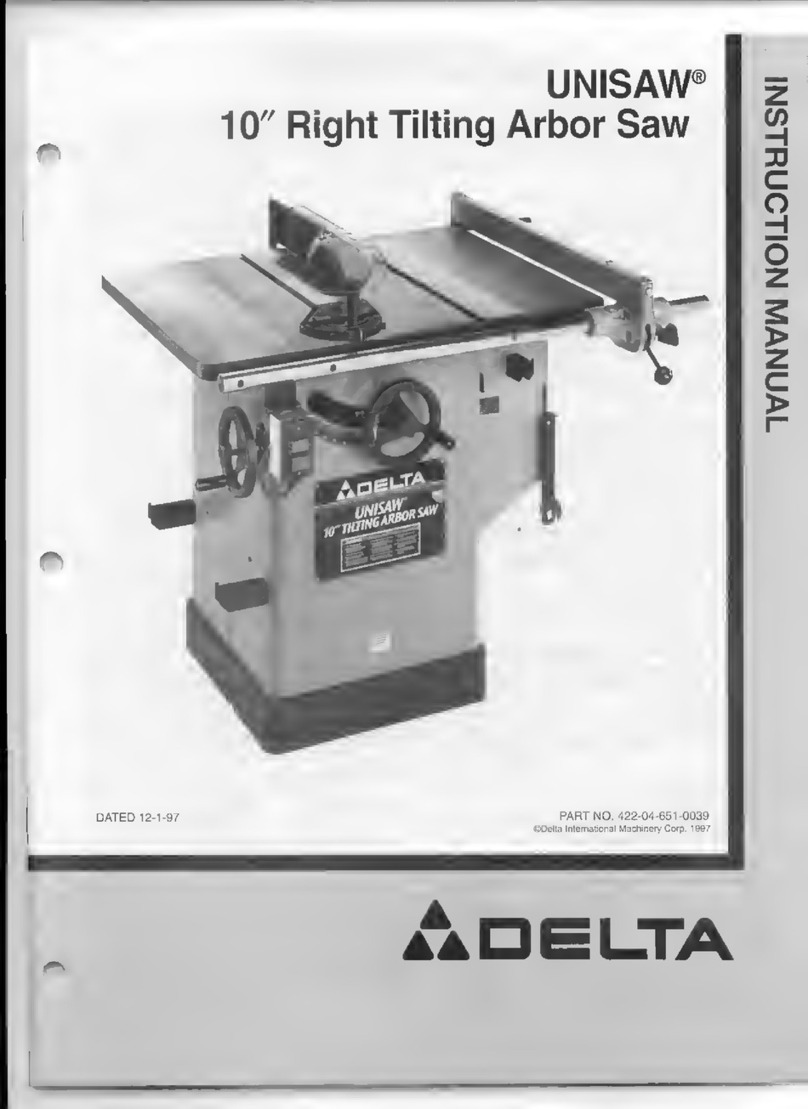
Delta
Delta UNISAW User manual
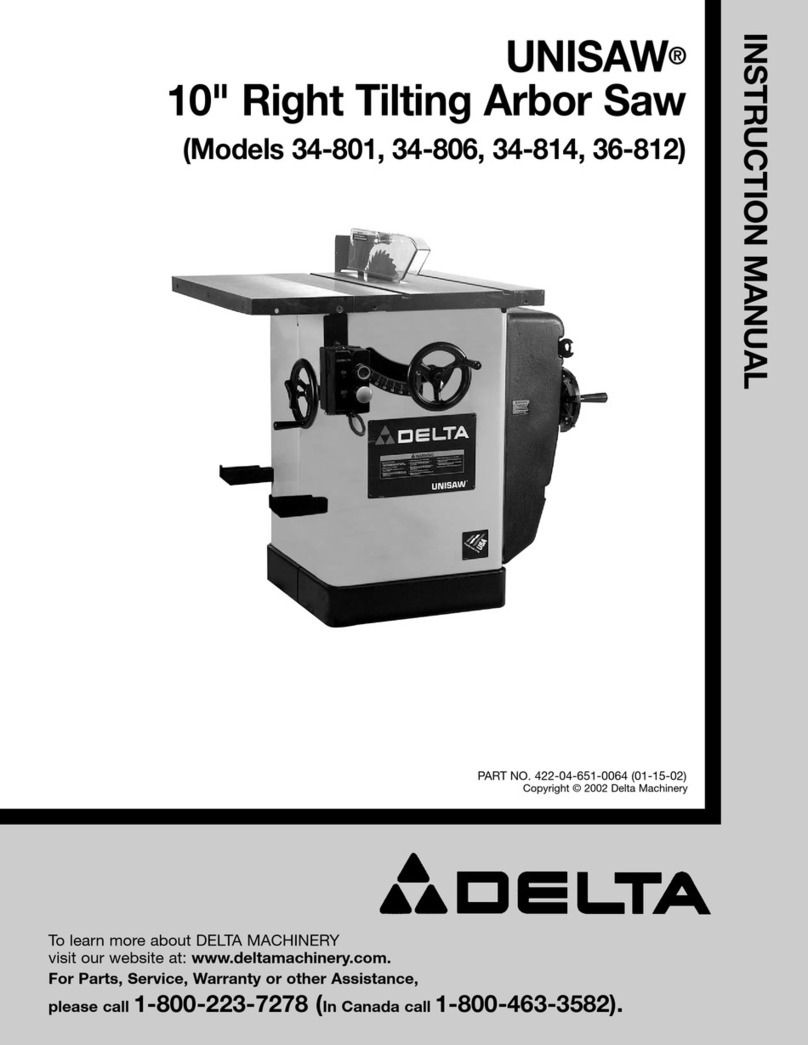
Delta
Delta UNISAW 34-801 User manual
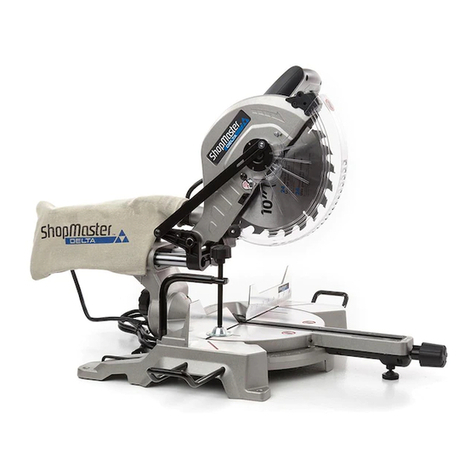
Delta
Delta ShopMaster S26-262LS User manual
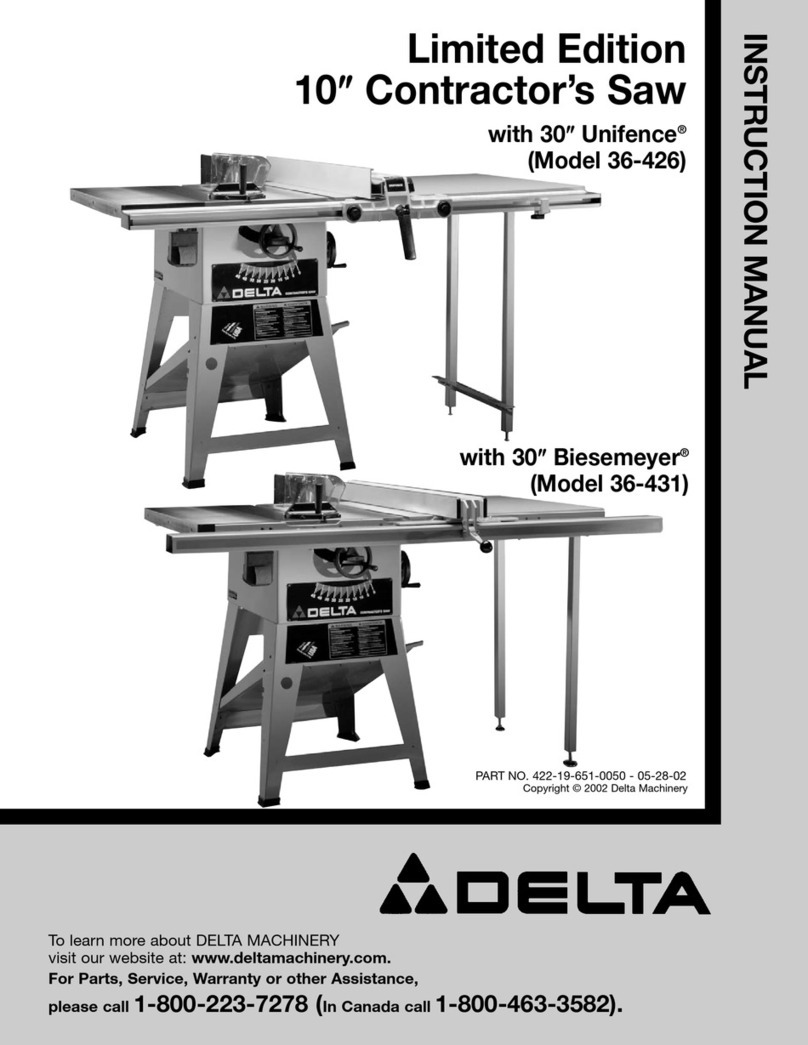
Delta
Delta 36-426 User manual
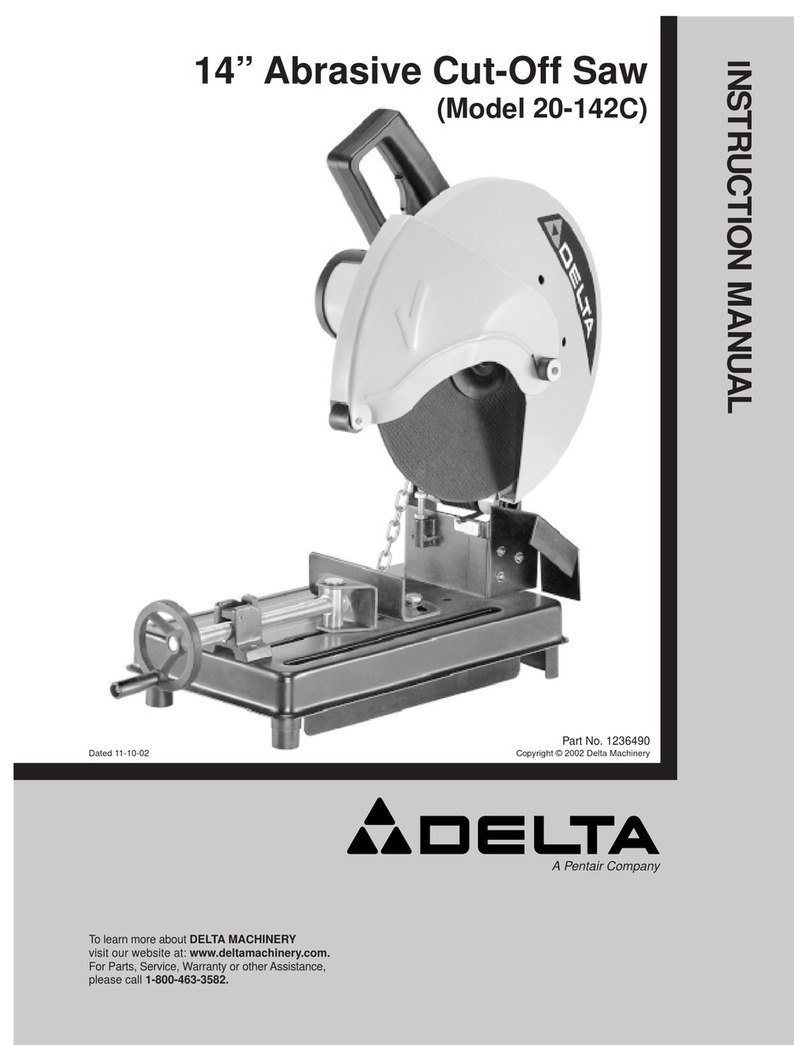
Delta
Delta 20-142C User manual
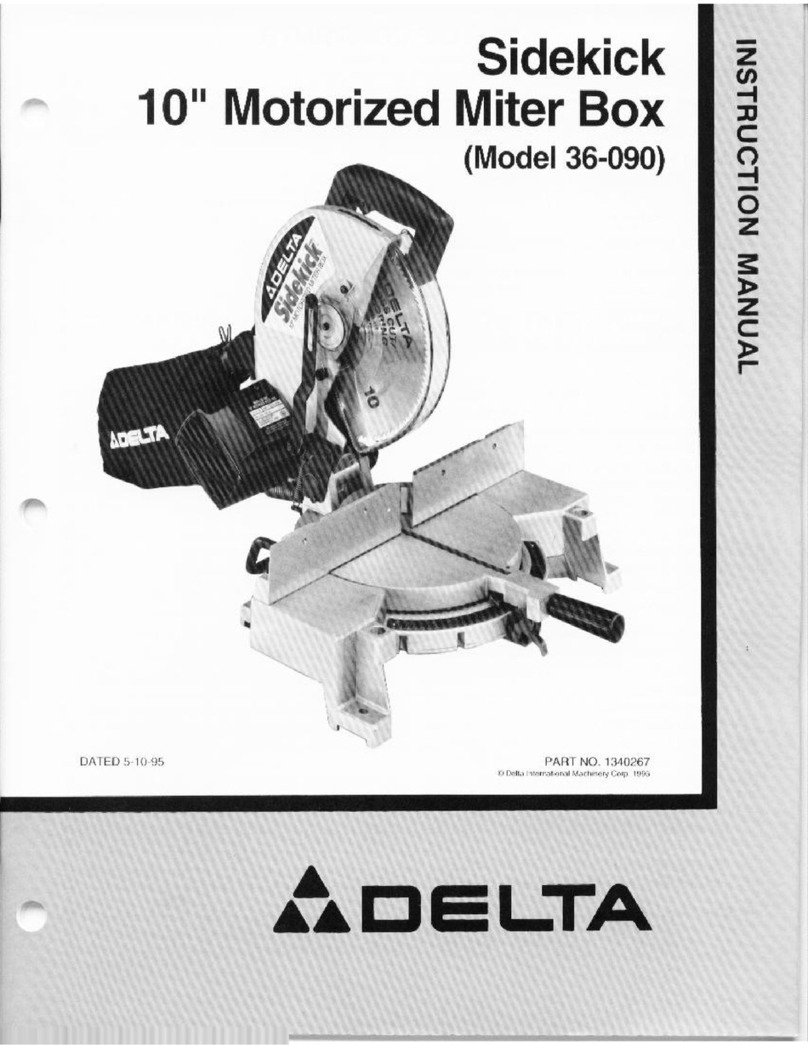
Delta
Delta SIDEKICK 10" MOTORIZED MITRE BOX 36-090 User manual

Delta
Delta 40-694 User manual
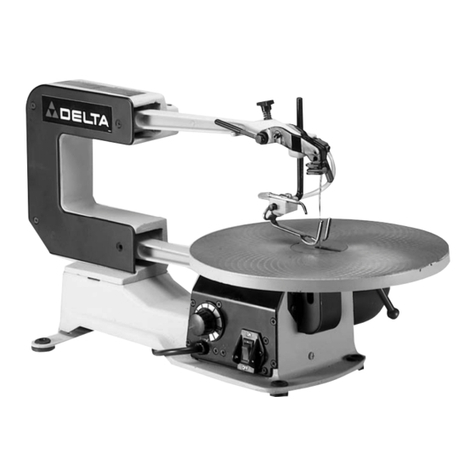
Delta
Delta 40-540 User manual

Delta
Delta TwinLaser 36-255L Instruction Manual
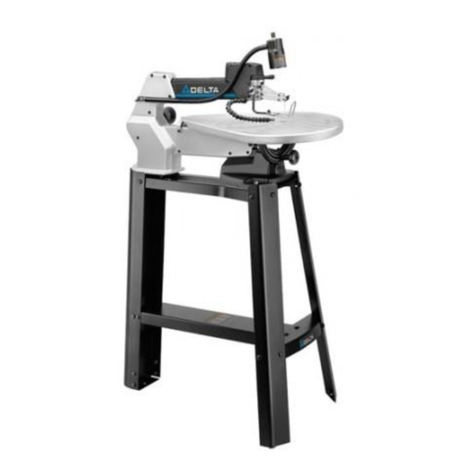
Delta
Delta 40-690 User manual
Popular Saw manuals by other brands
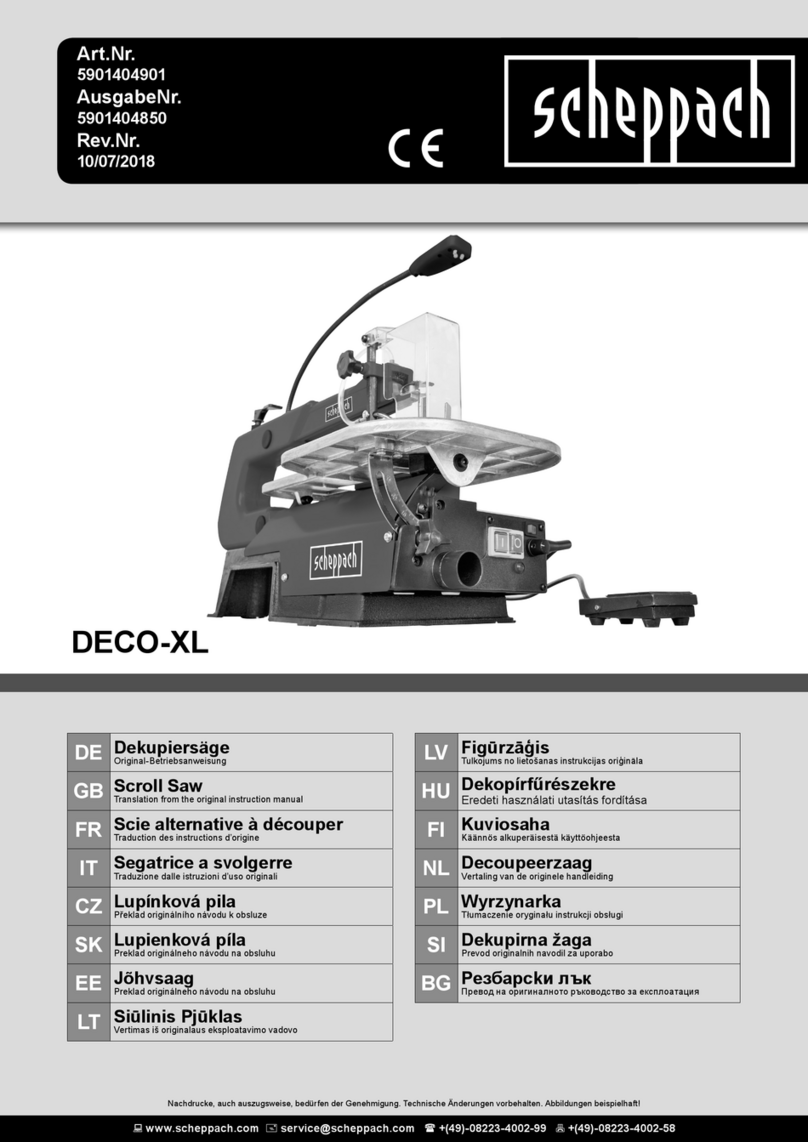
Scheppach
Scheppach DECO-XL Translation from the original instruction manual
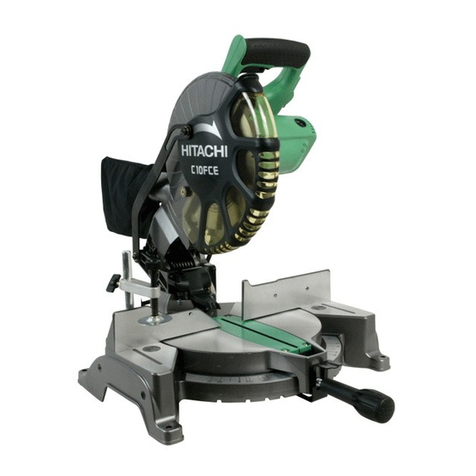
Hitachi
Hitachi C 10FCE Technical data and service manual
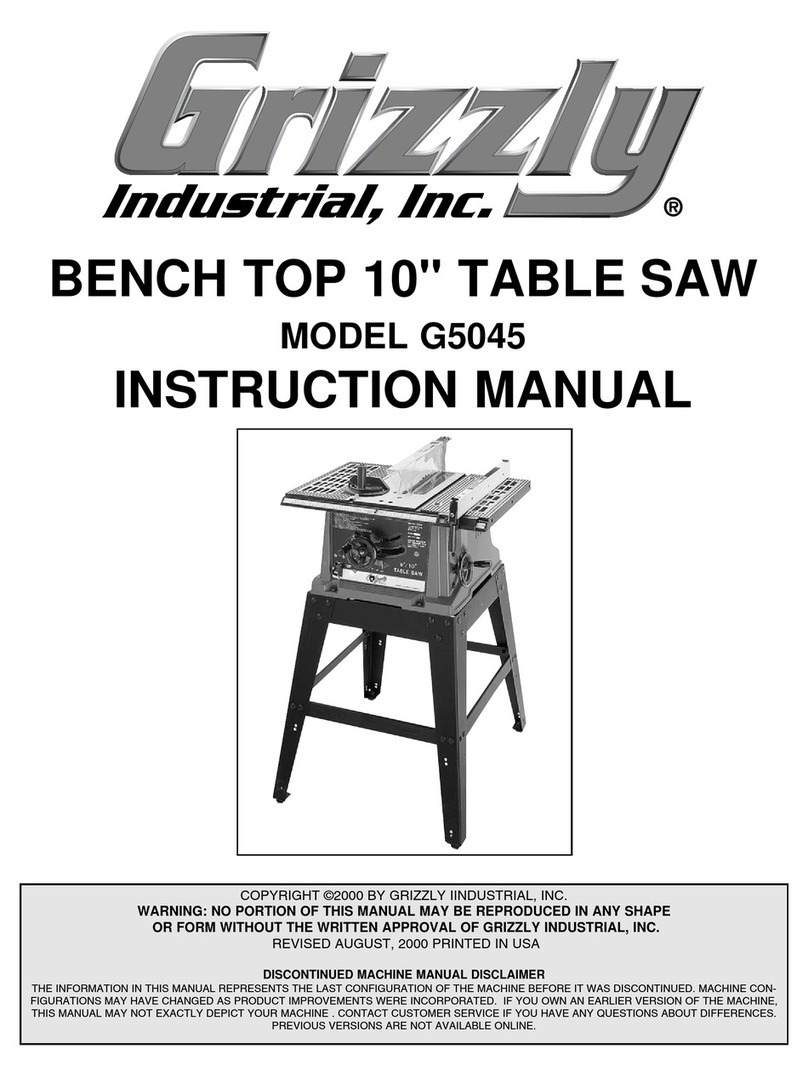
Grizzly
Grizzly G5045 instruction manual
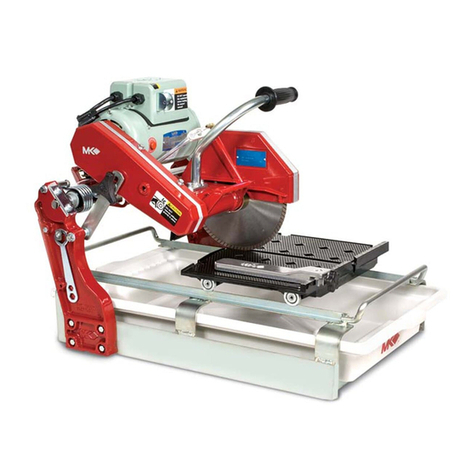
MK Diamond Products
MK Diamond Products MK-1080 Operations & parts manual
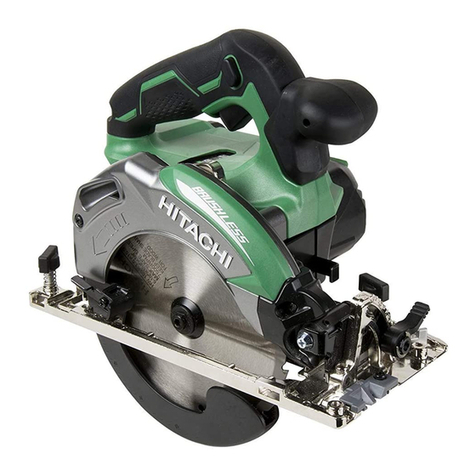
HIKOKI
HIKOKI C 18DBAL Handling instructions
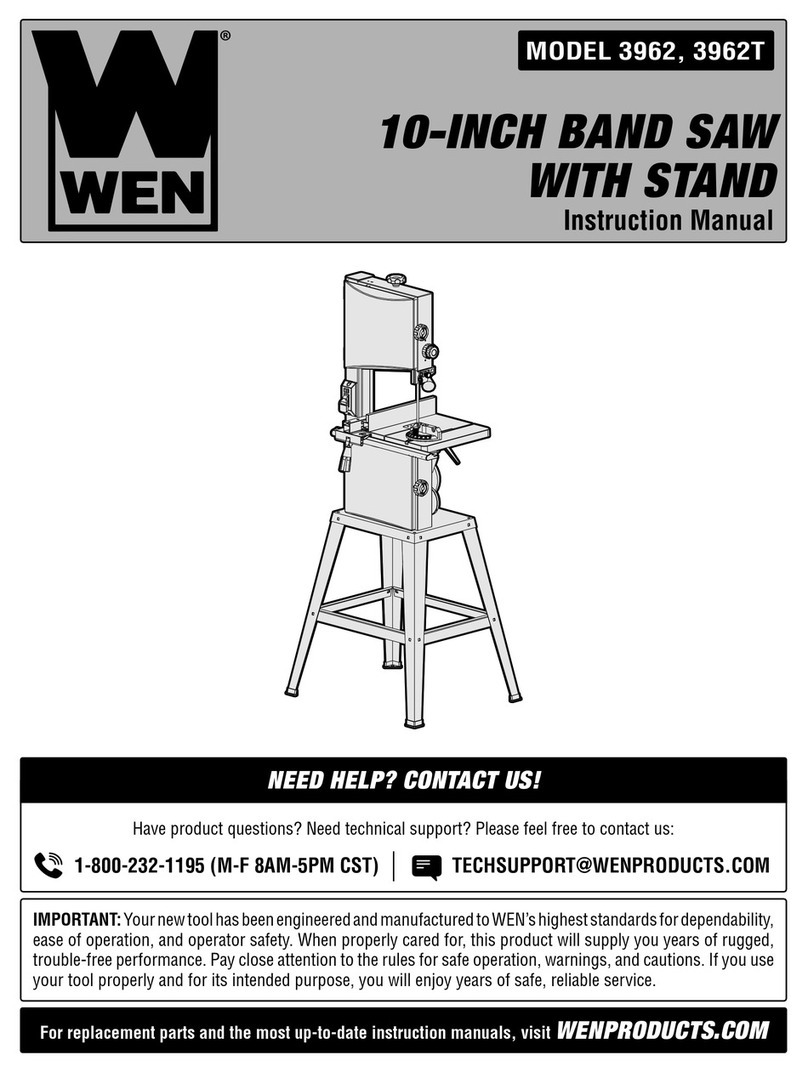
Wen
Wen 3962T instruction manual

